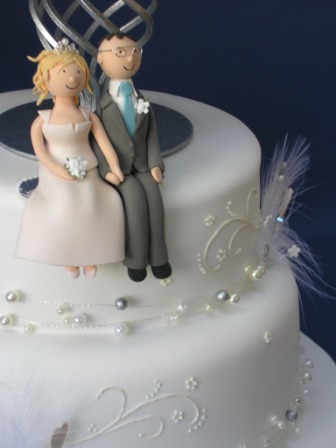|
 Wedding
Cakes Wedding
Cakes
Your wedding is a unique event and A Spoonful of
Sugar can provide the perfect cake.
Whatever you choose traditional or contemporary - we
carefully match your colours and themes to ensure your
celebration is complete.
All our designs are
individually priced depending upon the amount of
work involved.
Whichever
design you choose, the price also includes the
following:
·
Consultations to discuss your individual
requirements
·
Delivery and set up at your chosen venue, if
required (within a 25 mile radius of Southend-on-sea)
How many tiers will you need?
The following is an approximate guide to the amount of
portions you will get from your cake. The round sizes
can be used to assess the amounts from other shapes
such as; heart, hexagonal, octagonal and petal. This
guide is based on fairly generous portion sizes and so
you may get more from your cake if the person cutting
it is experienced and accurate!
|
SIZE
|
FRUIT |
SPONGE |
|
5 ROUND |
14 |
7 |
|
5 SQUARE |
16 |
8 |
|
6 ROUND |
22 |
11 |
|
6 SQUARE |
27 |
14 |
|
7 ROUND |
30 |
15 |
|
7 SQUARE |
40 |
20 |
|
8 ROUND |
40 |
20 |
|
8 SQUARE |
54 |
27 |
|
9 ROUND |
54 |
27 |
|
9 SQUARE |
70 |
35 |
|
10 ROUND |
68 |
34 |
|
10 SQUARE |
90 |
48 |
|
11 ROUND |
86 |
43 |
|
11 SQUARE |
112 |
56 |
|
12 ROUND |
100 |
50 |
|
12 SQUARE |
134 |
67 |
A HISTORY OF WEDDING CAKES
The wedding cake has a rich symbolic history of its own that
is relatively forgotten today. The ancient Greeks
threw small cakes at the newly married couple, just as
we throw confetti today. In Roman times, at the
marriages of the upper classes, the cake made of
flour, salt and water would firstly be shared by the
bride and groom, which was thought to promise the
couple a life of plenty, in both children and
happiness. The remainder was then broken over the
bride's head and the guests would rush to gain a piece
of the cake for themselves in the hope of sharing the
blessing.
At the wedding ceremonies of the early Anglo Saxons a
huge basket of dried biscuits was provided, where the
guests would take one each and the remainder was
shared amongst the poor. However, in later times the
wedding guests would bring their own cakes, often
spiced buns, which were placed in a pile. It was
thought that if the bride and groom could kiss each
other over the mountain of cakes, this would bring
life-long happiness and good fortune.
In Victorian times, the tradition of breaking the cake over
the bride's head was believed to promote fertility.
Unmarried girls would pass a piece of the cake through
the bride's wedding ring and place it under their
pillow believing that they would dream of their future
husband.
The cutting of the cake was once the sole responsibility of
the bride and was symbolic of the bride's pending loss
of virginity. The bride and groom today cut the first
slice of wedding cake as a symbol of unity. The
distribution of the cake among the guests is symbolic
of the sharing of happiness and hence the tradition
of sending a piece of cake to those unable to attend
the ceremony.
|





